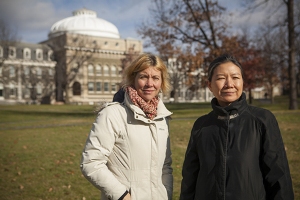Dec 9 2013
A campuswide exhibition next fall will explore the cultural and human consequences of seeing the world at the micro and macro levels, through nanoscience and networked communications.
 CCA Director Stephanie Owens, left, and artist kimsooja toured the Arts Quad Nov. 23, the intended site of the artist's installation project in the 2014 CCA Biennial. Source: Lindsay France/University Photography
CCA Director Stephanie Owens, left, and artist kimsooja toured the Arts Quad Nov. 23, the intended site of the artist's installation project in the 2014 CCA Biennial. Source: Lindsay France/University Photography
From Sept. 15 to Dec. 22, the 2014 Cornell Council for the Arts (CCA) Biennial, “Intimate Cosmologies: The Aesthetics of Scale in an Age of Nanotechnology,” will feature several events and principal projects by faculty and student investigators and guest artists – artist-in-residence kimsooja, Trevor Paglen and Rafael Lozano-Hemmer – working in collaboration with Cornell scientists and researchers.
The inaugural biennial theme was chosen to frame dynamic changes in 21st-century culture and art practice, and in nanoscale technology. The multidisciplinary initiative intends to engage students, faculty and the community in demonstrations of how radical shifts in scale have become commonplace, and how artists address realms of human experience lying beyond immediate sensory perception.
“Participating in the biennial is very exciting. We’re engaging the idea of nano and investigating scale as part of the value of art in performance,” said Beth Milles ’88, associate professor in the Department of Performing and Media Arts, who is collaborating on a project with students and with artist Lynn Tomlinson ’88.
“Lynn and I come from different approaches to similar disciplines, and are creating 13 sites and 13 different performance pieces,” she said. “As collaborators, the prompt of the CCA biennial theme encouraged us to explore forms we were already interested in, and now we have the opportunity to construct something with our students. They’re engineers, computer students, artists … we’re encouraging cross-disciplinary investigation and research.”
A series of events and curricula this fall and spring are preceding the main Biennial exhibition. Joe Davis and Nathaniel Stern ’99 presented talks this semester, and CCA will bring Paul Thomas, Stephanie Rothenberg, Ana Viseu and others to campus in the coming months.
kimsooja, an acclaimed multimedia artist in performance, video and installation, addresses issues of the displaced self and recently represented Korea in the 55th Venice Biennale. She visited the campus Nov. 22-23 to meet with Uli Weisner and students from his research group, who will work with her to realize her large-scale installation here next fall.
Lozano-Hemmer has worked on both ends of the scale spectrum, from laser-etched poetry on human hairs to an interactive light sculpture over Mexico City, Toronto and Yamaguchi, Japan. Paglen’s researched-based work blurs lines between science, contemporary art, journalism and other disciplines.
The Biennial focus brings together artists and scientists who share a common curiosity regarding the position of the individual within the larger world, CCA Director Stephanie Owens said.
“Scientists are suddenly designers creating new forms,” she said. “And artists are increasingly interested in how things are structured, down to the biological level. Both are designing and discovering new ways of synthesizing natural properties of the material world with the fabricated experiences that extend and express the impact of these properties on our lives.”
Owens is teaching “Micro Materialities/Macro Forms: Artistic Practice and the Culture of Nano Science” this semester, featuring class visits with Hod Lipson at the Creative Machines Lab and Uli Weisner, whose Weisner Group works with C-dots, fluorescent nanoparticles that increase the refractive distance of light waves.
“Today, art practice is a convergence of many disciplines – which, rather than dilute the experience of art, multiplies and opens up the ways in which artists engage the world around them. This often leads to surprising overlaps in human intention across all disciplines,” Owens said.
Biennial projects: Big ideas in small scale
Several Cornell faculty and student investigators are mounting research-based projects for the Cornell Council for the Arts’ 2014 Biennial next fall, “Intimate Cosmologies: The Aesthetics of Scale in an Age of Nanotechnology.” The principal projects to be presented are:
- “eSkin” – Architecture professor Jenny Sabin addresses ecology and sustainability issues with buildings that behave like organisms. Her project is an interactive simulation of a façade material incorporating nano- and microscale substrates plated with human cells.
- “Nano Performance: In 13 Boxes” – Performing and media arts professor Beth Milles ‘88, animator/visual artist Lynn Tomlinson ‘88 and students from different majors will collaborate on 13 media installations and live performances situated across campus. Computer mapping and clues linking the project’s components will assist in “synthesizing the 13 events as a whole experience – it has a lot to do with discovering the performance,” Mills said.
- “Nano Where: Gas In, Light Out” – Juan Hinestroza, fiber science, and So-Yeon Yoon, design and environmental analysis, will demonstrate the potential of molecular-level metal-organic frameworks as wearable sensors to detect methane and poisonous gases, using a sealed gas chamber and 3-D visual art.
- “Paperscapes” – Three architecture students – teaching associate Caio Barboza ’13; Joseph Kennedy ’15 and Sonny Xu ’13 – will render the microscopic textures of a sheet of paper as a 3-D inhabitable landscape.
- “When Art Exceeds Perception” – Ph.D. student in applied physics Robert Hovden will explore replication and plagiarism in nanoscale reproductions, 1,000 times smaller than the naked eye can see, of famous works of art inscribed onto a silicon crystal.